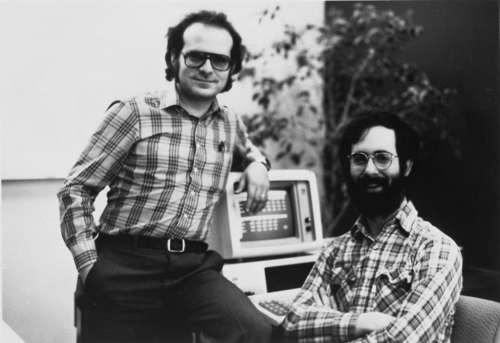| Dan Bricklin - Inventor of the PC Spreadsheet |
| Written by Historian | ||||||
Page 2 of 2
Bob FrankstonThe next step was an assembly language version but this was more than Bricklin could attempt given that he was just starting his second year of the MBA course. Enter Bob Frankston. Bricklin had met Frankston while at MIT and there had been a sort of agreement that one day they would start their own company and the spreadsheet idea seemed the ideal thing. Frankston would write the code and Bricklin would oversee the design.
Frankston and Bricklin As is the tradition of such early startups, Frankston worked the nightshift to save money on the timeshare service that decided they needed to use to create the program. They set up a company, Software Arts, with Bricklin as Chairman and Frankston as President. At this stage more sophisticated problems arose such as how to implement replication and absolute and relative cell references. The final version of the program had to be a compromise of features and performance and the first assembly language version used only 25KBytes of RAM (there isn't a zero missing it really was 25KBytes) but it only worked with integers and could only do addition and subtraction. Apple was shown the first version and failed to see any value in it. Atari thought it was good but didn't have a machine ready. Flystra on the other hand agreed to distribute it for a huge 64.3% of the revenue falling to 50% for bulk deals. VisiCalcAt first things moved slowly but the worth of the program spread, mainly by word of mouth and in the second year the Apple version of Visicalc was selling 1000 per month. Bricklin and Frankston had invested in their company - $20,000 in cash and a loan of $65,000 - which was spent on two programmers and a Prime 550 mini. Conversion of VisiCalc to the TRS-80, a Z80 processor was accomplished by the use of an automatic translation program - a clever cross assembler. All that was needed was some hand modification to the output. Years later they discovered that the bugs in the 6502 code from the Apple had been perfectly translated into the Z80 code. They used the same technique to convert VisiCalc to the IBM PC. This ensured that they could get the program onto the machine quickly but it also gave Lotus the chance to get in and produce a better program. A program that is translated can never be as efficient as one that is hand crafted for a specific processor. Hence Lotus could produce something faster and with more features in the same amount of memory - but exactly how they did it is another story. VisiCalc made the Apple and the IBM PC a success. IBM wouldn't even announce their PC until VisiCalc was ready. People would buy a personal computer simply to run VisiCalc. It sold the personal computer to the mass market who could at last work with numbers and construct models without having to write programs. The triumph of the spreadsheet continues today with it still ranking as the number two application after word processing. Early VisiCalc From success to failureAfter creating the spreadsheet Software Arts appeared to lose focus. Bricklin worried about producing a second product for fear of it ruining their superb track record in selling VisiCalc. At its peak it sold 2 million copies at $150 per copy in 12 months! This was Dan Bricklin's high point as well because he was given the Grace Hopper Award for significant accomplishment in computers by people under 30. After this it seemed to be all down hill. Eventually Software Arts did produce TK!Solver, an early attempt at an equation solving program, and SpotLight, an early pop-up desktop manager but nothing reached the level of success of Visicalc. However this one-product approach shouldn't lead you to think that the company was working hard to keep VisiCalc at the top. They were very slow with new releases and left the market wide open for a competitor to produce something better. The main reason is that just as Software Arts was thinking of going public it was hit by a lawsuit from VisiCorp, Dan Flystra's renamed distribution company. They were just in the process of producing VisiOn, which they though would replace VisiCalc as their best earner. There were lots or arguments between Software Arts and VisiCorp but the final split resulted in a $60 million lawsuit alleging that Software Arts had failed to enhance VisiCalc and produce new versions. Software Arts hit back with a lawsuit claiming that VisiCorp had favored its own products at the expense of VisiCalc. This messy lawsuit brought the progress of the company share issue to a halt. No one wants to buy into a company when it is in the middle of litigation. Eventually the case was settled out of court with VisiCorp paying Software Arts $500,000 and releasing them from their contract. But it was too late. By the time it was all over Lotus 1-2-3 had the market and the company that was once worth $50 million was almost worthless. Lotus picked up Software Arts' products and other assets for next to nothing and in doing so avoided the `look-and-feel' lawsuit that Software Arts might have won against them in the following decade! For more visit Dan Bricklin's Web Site To be informed about new articles on I Programmer, sign up for our weekly newsletter, subscribe to the RSS feed and follow us on Twitter, Facebook or Linkedin.
Comments
or email your comment to: comments@i-programmer.info
<ASIN: 0470402377> <ASIN:B0000A9GLO> <ASIN:0596527055> <ASIN:B00006FXQO> |
||||||
| Last Updated ( Friday, 21 September 2018 ) |



